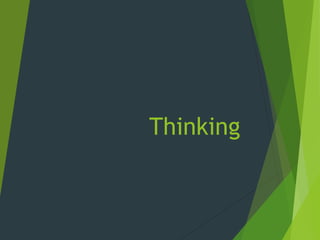
4.Thinking (1).pptx
- 1. Thinking
- 2. Thinking
- 3. Thinking Thinking in psychology is the process of consciously generating and manipulating thoughts and ideas in the mind. Thinking is an essential process for humans. It allows us to solve problems, learn new information, understand concepts, and process our experiences. Thinking involves the entire process of learning, remembering, and organizing mentally to understand the information better and recall it later.
- 4. Nature of thinking It is essentially a cognitive activity It is always directed to achieve some end or purpose It is describe as a problem solving behavior It is a symbolic activity it can shift very rapidly
- 5. Thinking Thinking can refer to the act of producing thoughts or the process of producing thoughts Thinking is the ultimate cognitive activity, consciously using our brain to make sense of the world around us and decide how to respond to it Thought can refer to the ideas or arrangements of ideas that result from thinking A thought may be an idea, an image, a sound or even an emotional feeling
- 6. Thinking allows humans to make sense of interpret, represent or model the world they experience, and to make predictions about that world In spite of the fact that thought is a fundamental human activity familiar to everyone, there is no generally accepted agreement as to what thought is or how it is created
- 7. Theories and Models of Thinking Behaviorist Theory Behaviorists view thinking as something that produces a measureable change in an individual’s actions. Since thinking takes place as a result of reacting to external stimuli in this model Pavlov’s famous experiment about dogs salivating when they would hear the dinner bell ring is an example of behaviorist theory Cognitive Theory Cognitive theorists such as Piaget and Gagne argue that thinking and learning are internal mental actions that take place in the brain and include sensory perception, processing of information, applying and combining information, and memory
- 8. Humanist Theory In the humanist model, the purpose of thinking is to fulfill an individual’s potential. As such, the acts of thinking and learning are always personal, not institutional. Also known as “whole child” theory, humanists advise that the purpose of education is to develop a self-motivated, autonomous individual who can think and learn on his own
- 10. Different Types of Thinking Perceptual Thinking- This is the simplest type of thinking. The basic of this type of thinking is perception. This type of thinking is mostly seen in animals, Children . Conceptual thinking consists of the ability to find connections or patterns between abstract ideas and then piece them together to form a complete picture
- 11. Logical Thinking It aims at solving complex problems rather than simple problem.it requires organization of all the relevant experiences and finding new way of reacting to the situation. Critical thinking – Critical thinking is an higher order well disciplined thought process.it is used in solving critical problems. E.g. Nurse
- 12. Creative thinking – This type of thinking aims at crating something new. In this the individual himself formulates the problem and free to invent tools for the solution. E.g. Scientist Innovative thinking involves generating new ideas or new ways of approaching things to create possibilities and opportunities
- 13. Convergent Thinking: Convergent thinking is the process of coming up with the best answer to a question using our memory, resources around us, or logic Many Solution Divergent Thinking: Divergent thinking is the exact opposite of convergent thinking. It involves coming up to solutions, paths forward or new ideas when there is no single correct answer Single standard solution
- 14. Problem solving It is a tool, skill and process It is a tool because it can help you solve an immediate problem or to achieve a goal It is a skill because once you have learnt it you can use it repeatedly, like the ability to ride a bicycle, speak a language It is also a process because it involves thinking a number of steps Every time you use problem solving process, you are increasing your problem solving skills
- 15. Steps in problem solving- cycles 1. Identify the problem 2. Explore the problem 3. Set goals 4. Look at alternatives 5. Select a possible solution 6. Implement a possible solution 7. Evaluation